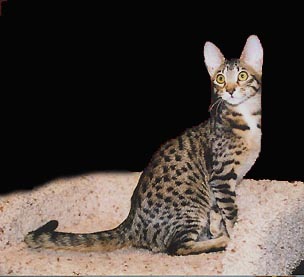The Serengeti Cat---
---a new domestic breed
Created by Karen Sausman of Kingsmark Cattery in California in 1994, the Serengeti Cat breed is accepted in TICA and can be shown in Advanced New Breed classes at TICA shows.
BREED STANDARD
APPROVED MARCH 2013
POINT SCORE
HEAD - 35 points
SHAPE - 4
EARS - 12
EYES - 5
CHIN - 2
MUZZLE - 2
NOSE - 1
PROFILE - 5
NECK - 4
BODY - 30 points
TORSO - 5
LEGS - 10
FEET - 2
TAIL - 3
BONING - 5
MUSCULATURE - 5
COAT/COLOR/PATTERN - 35 points
LENGTH - 3
TEXTURE - 2
PATTERN - 20
COLOR - 10
CATEGORY: Traditional
DIVISIONS: Tabby, Solid and Silver/Smoke Division.
COLORS: Tabby Division: Brown spotted ONLY
Solid Division: Black ONLY.
Silver/Smoke Division: Black silver spotted and black smoke.HEAD:
Shape: The head is longer than it is wide; a modified wedge, starting at the nose and flaring out in a straight line to the base of ears forming a triangle with a slight break at the whiskers. Cheeks should not be prominent.
Ears: Wide and deep at the base with rounded tips. Strikingly large, equal to the length of the head. Set upright and close together on the top of the head.
Eyes: Round and large. Neither protruding nor recessed. Separated by a broad nose. Much more than an eye width apart. Gold or yellow eye color preferred, hazel to light green allowed.
Chin: Strong and lines up with tip of nose in the same vertical plane, neither receding nor excessively massive.
Muzzle: Medium with moderately full and rounded whisker pads. With a slight break at the whiskers.
Nose: Moderately wide, even width throughout length.
Profile: Straight line from the nose to the brow, then gently loping to the top of the head, flowing into an arched neck.
Neck: Long in proportion to body. Flowing from the shoulder with no taper into the back skull.
BODY:
Torso: Semi-foreign and solid with a substantial torso of good depth. Rump and shoulders should be the same level giving a very upright posture. Males may be somewhat larger than females.
Legs: Extremely long with medium boning and musculature.
Feet: Medium, oval.
Tail: Thick and tapering slightly from the body to the end. Medium, ideally short of shoulder when laid along torso.
Boning: Medium leg boning.
Musculature: Long and lean.
COAT:
Length: short and even
Texture: Fine textured, dense, with some loft
COLOR:
Tabby Division: Any shade of brown with high contrast between the ground color and the spots. Light to white underbelly, chin and front of muzzle. Back of ears with eye spot. Glitter acceptable.
Solid Division: Black solid, ghost spots may be visible .
Silver/Shaded Division: Black spots on a clear silver body; black smoke
PATTERN:
Random spotted or solid. On spotted cats preference given to random high contrast spot pattern, spot pattern on shoulders and hips extending down the legs and black rings around the tail. Two-toned spots (rosettes) should be penalized.
OTHER:
Balance: Square build with level topline.
Condition: Well muscled
Temperament: Confident. Must be unchallenging.
GENERAL DESCRIPTION: The ideal Serengeti Cat is a medium sized cat with long legs. It should be in excellent physical condition, strong and muscular. It should appear as a graceful, statuesque, squarely built cat with a very upright posture. Also noticeable is the long neck, which blends into the base of the skull without tapering. Strikingly large round-tipped ears, equal to the length of the head, are one of the main features of the Serengeti. They should have a gentle, confident, outgoing and alert temperament.
ALLOWANCES: None
PENALIZE: Spots tending toward bars on side of body; two-toned (rosetted) spots; heavy ticking; small ears; short legs
WITHHOLD ALL AWARDS: White tail tip, toes or white anywhere on the body. Miniaturization. Blue eyes.
.................................
Temperament must be unchallenging; any sign of definate challenge shall disqualify. The cat may exhibit fear, seek to flee, or generally complain aloud but must not threaten to harm.
Evidence of intent to deceive the judge by artificial means, cats with all or part of their tail missing (except those breeds whose standard calls for this feature), totally blind cats, cats having more or less than five toes on each front foot and four on each back foot (unless proved to be the result of an injury or as authorized by a Board approved standard), and, at the discretion of the judge, tail faults (visible or invisible) and/or crossed yes shall be disqualified from championship competition. See Show Rules, ARTICLE SIXTEEN for comprehensive rules governing penalties/disqualifications applying to all breeds.
..................................
CLICK HERE - For some of the points of the standard illustrated.

Kingsmark Bengal and Serengeti Cats
Marana, AZ
Call: 520-616-4649
E-mail: KSerengeti@aol.com
| All About Serengeti Cats |
My Serengeti Photo Gallery |
|---|---|
| Serengeti Ancestors | Serengeti Illustrated Standard |
